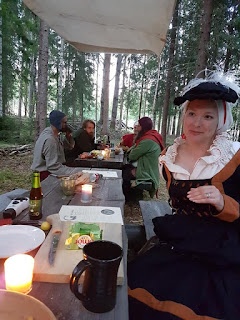As another handicraft exchange I made a pair of 16th century trousers. They are actually Swedish, not German for once.
The inspiration comes from a drawing made by Paul Dolnstein from 1502. Paul Dolnstein took part in a landsknecht army in the late 15th and early 16th century and he kept a diary, in which he draw pictures of what he experienced. In 1502 he was in south Sweden with an army of King Hans of Denmark and took part in the siege of Älvsborg. Most of the Swedish soldiers were farmers summoned by the King to fight in the army when needed. In the book The Landsknecht soldiers 1486-1560 the farmers are described as "Swedish crossbowmen from Västergötland, who wear a motley collection of old-fashioned helmets and their characteristic baggy trousers." In the drawing below its the Swedish men to the right.
Here is another drawing by Paul Dolnstein showing a Swedish man in the same type of trousers.
To
get an idea of how they could have been constructed I looked at
patterns for folk costumes, regular 15th and 16th century hose and landsknechtspants. I have not made trousers before so I wanted to look at a couple of different examples. When I look at this drawing I don´t see a codpiece, so even though they are very common in the fashion of the time I decided to make the trousers without one. The front is going to be just straight with eyelets and a fingerloop braided string. I don´t make them bias cut either, no need when they are wide.
So more towards folk costume and less
landsknecht and hose. While making them I started to look for other sources to this type of baggy trousers. And there are some.
In Ask church in Sweden we can see this guy. Its painted during the late 15th century.
And this guy, who suppose to be from Finland. Its from Olaus Magnus "Historia om de nordiska folken" from 1555.
In Göte Göranssons book "Gustav Vasa och hans folk" there is a couple of drawings of people in pants like these, peasants and peasant soldiers.
In the book the description to this drawing is (Translated from Swedish) " Peasant soldiers in their traditional baggy long trousers met professional landsknecht".
However, I dont know where he got his inspiration for these from.
It feels like great fun to try something totally new. We decided to make them in wool with a linen lining. Its red light weight wool and unbleached linen from Handelsgillet. After getting his measurements and putting together a pattern I cut it out in an old sheet just to be able to try it out. I don´t have any pictures of that. But after cutting it out of the linen fabric the pattern for one leg looked like this.
The bottom part is just a squared piece.
And when cutting both legs out and pinned them together it looks like this. The waistband is still missing in this picture though.
I wanted to try it out again before I started to sew. In theses corona-times I could not do it myself so Henriks wife got to help while I was taking pictures. I made them way too long but that is better than too short. And a bit big, but quite good otherwise. Here I also cut out the wool pieces to be able to try everything together. The fabric and lining is basted to secure them together while working with the garment. Much better than pins while trying them out and working on them by hand. You do this to make the layers stay flat together.
They are made only by hand. I used waxed linen thread and a half back stitch. The seam allowance is folded down and whip stitched.
The front closing is just four eyelets and a string made by fingerloop braiding. The waistband is slightly narrowed in to make it stay on the hips without lacing it to a jacket the way that is common during the 15th and early 16th century otherwise.
And the inside. All the seam allowance is folded down and whip stitched.
In retrospect i think I could have made them even wider. But the wideness need to be compared to the tight hose and when looking at it from that perspective they are wide enough. Maybe, if I do another pair I might make them wider.
The fingerloop braid.
The verdict from Henrik was "A little bit big around the waist but very comfy".
Sources:
Landsknecht soldier 1486-1560 by John Richards
Gustav Vasa och hans folk by Göte Göransson
The Tudor Tailor by Ninya Mikhaila and Jane Malcome-Davies
The Kings servants by Calorine Johnsson, Ninya Mikhaila and Jane Malcom-Davies
Historisk dräkt inifrån och ut Handbok 1400 Mansdräkt by Anna Malmborg and Willhelm Schütz
http://medeltidbild.historiska.se/medeltidbild/visa/foremal.asp?objektid=920830M1
https://historiskdrakt.wordpress.com/2012/06/30/husurnas-aterkomst/?fbclid=IwAR0yh-XoJ7FfA74xtqW7VZarYIfVLzI6GWGu6DfPMXsXVXvIhvQHwrX9nlY
https://kurage.wordpress.com/tag/byxor/?fbclid=IwAR1IxUe-DyrGSJe1GLI_I40GUQGo7RQgHqEA1lMJCQhEWS7SmUs9y6QQdP0
Inspiration for my pattern comes from a pattern for trousers for the folk costume of Mora, in Dalarna, Sweden. The pattern could be purchased from Mora hemslöjd
I did not use that pattern straight off, but it was of great help as inspiration.


































